Biology:Nymphaea × daubenyana
| Nymphaea × daubenyana | |
|---|---|

| |
| Nymphaea × daubenyana cultivated at the Brooklyn Botanic Garden, New York, USA | |
| Scientific classification | |
| Kingdom: | Plantae |
| Clade: | Tracheophytes |
| Clade: | Angiosperms |
| Order: | Nymphaeales |
| Family: | Nymphaeaceae |
| Genus: | Nymphaea |
| Species: | N. × daubenyana
|
| Binomial name | |
| Nymphaea × daubenyana W.T.Baxter ex Daubeny[1]
| |

| |
| It is endemic to Chad, but has been introduced to Florida, USA[1] | |
| Synonyms[1] | |
| |
Nymphaea × daubenyana is a species of waterlily endemic to Chad, but has been introduced to Florida, USA. It is a natural hybrid of Nymphaea micrantha and Nymphaea nouchali var. caerulea.[1]
Description
Vegetative characteristics
It has a tuberous rhizome. The cordate, elliptical-roundish, 30 cm wide leaves have an entire margin. The adaxial surface is coloured brightly green with red marks. The abaxial leaf surface is pale - brownish red. Proliferating tissue is found on the leaf blade above the attachment point of the petiole.[2][3]
Generative characteristics
The blue flowers are 10 cm wide. The narrow petals have an acute apex.[3][2] The ovules are bitegmic and anatropous.[4] The flowers are fragrant.[5][6][7]
Cytology
A chromosome count of 89 or 87 chromosomes has been reported.[8] The diploid chromosome count has also been reported to be 2n = 42.[9]
Reproduction
Vegetative reproduction
Vegetative reproduction through foliar proliferation occurs in Nymphaea × daubenyana.[3][10][11]
Taxonomy
Publication
It was first named by W.T.Baxter, but only later validly published by Charles Giles Bridle Daubeny (1795-1867) in 1864.[1]
Placement within Nymphaea
It is placed in Nymphaea subgenus Brachyceras.[12]
Etymology
It is named after Professor Charles Giles Bridle Daubeny.
Cultivation

It is suited for cultivation in small ponds, containers, and aquaria.[13][14][6][15] It is a fast growing and floriferous species.[6] Despite being a tropical waterlily, it is relatively cold-tolerant.[16]
References
- ↑ 1.0 1.1 1.2 1.3 1.4 "Nymphaea × daubenyana W.T.Baxter ex Daubeny" (in en). Royal Botanic Gardens, Kew. http://www.plantsoftheworldonline.org/taxon/928088-1. Retrieved 28 December 2023.
- ↑ 2.0 2.1 Nymphaea in Flora of North America @ efloras.org. (n.d.). Retrieved December 28, 2023, from http://www.efloras.org/florataxon.aspx?flora_id=1&taxon_id=122531
- ↑ 3.0 3.1 3.2 De Thabrew, W. V. (2014). "A Manual of Water Plants." pp. 181-182. USA: AuthorHouse.
- ↑ Kraehmer, H. (2019). "Grasses: Crops, Competitors, and Ornamentals." p. 95. John Wiley & Sons.
- ↑ Niklitschek, A. (1955). "Vom Zimmergarten der Zukunft: neue Tatsachen und Probleme." p. 190. Deutschland: Bruckmann.
- ↑ 6.0 6.1 6.2 "Illustrirte Garten-Zeitung." p. 21. (1883). Deutschland: (n.p.).
- ↑ Rodd, T., Bryant, G., & Barnard, L. (2007). "The plant finder: The Right Plants for Every Garden." p. 521. Richmond Hill, Ont. : Firefly Books.
- ↑ Tischler, G. F. L. (1953). "Allgemeine Pflanzenkaryologie: Ergänzungsband: Angewandte Pflanzenkaryologie." p. 445. Deutschland: Gebr. Borntraeger.
- ↑ Hossain, A., Kabir, G., Ud-deen, M. M., & Alam, A. M. S. (2007). "Cytological studies of Nymphaea species available in Bangladesh." Journal of Bio-Science, 15, 7-13.
- ↑ Labarre, E. J. (1935). “Viviparous” Succulents. The Cactus Journal, 4(2), 36–37. http://www.jstor.org/stable/42784943
- ↑ Schmucker, Th. (1932). PHYSIOLOGISCHE UND ÖKOLOGISCHE UNTERSUCHUNGEN AN BLÜTEN TROPISCHER NYMPHAEA-ARTEN. Zeitschrift Für Wissenschaftliche Biologie. Abteilung E. Planta, 16(2), 376–412. http://www.jstor.org/stable/23841796
- ↑ Weidlich, W. H. (1976). The Organization of the Vascular System in the Stems of the Nymphaeaceae. II. Nymphaea Subgenera Anecphya, Lotos, and Brachyceras. American Journal of Botany, 63(10), 1365–1379. https://doi.org/10.2307/2441845
- ↑ Böswirth, D., Thinschmidt, A. (2019). "Miniwassergärten (Mein Garten): Gestalten Pflanzen Pflegen." p. 72. Deutschland: Franckh-Kosmos Verlags-GmbH & Company KG.
- ↑ Heß, T. (2021). "Kosmos Gartenjahr 2022: Der praktische Arbeitskalender mit Aussaattagen." p. 84. Deutschland: Franckh-Kosmos Verlags-GmbH & Company KG.
- ↑ Nymphaea × daubenyana. (n.d.). Flowgrow. Retrieved December 28, 2023, from https://www.flowgrow.de/db/aquaticplants/nymphaea-daubenyana#:~:text=Nymphaea%20x%20daubenyana%20is%20a%20cultivated%20hybrid%20of,basis%2C%20which%20makes%20this%20Nymphaea%20easy%20to%20propagate.
- ↑ Nymphaea “Daubeniana” (Dauben, daubeniana). (n.d.). North Carolina Extension Gardener Plant Toolbox. Retrieved December 28, 2023, from https://plants.ces.ncsu.edu/plants/nymphaea-daubeniana/
Wikidata ☰ Q11702833 entry
 |



